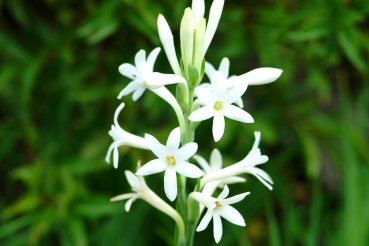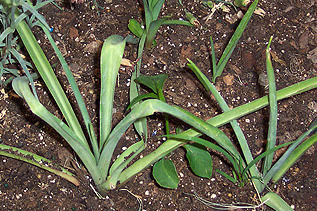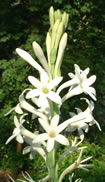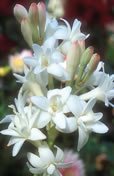
|
Tuberose (Poliyantha tuberosa)
|
Characteristics

Tuberose is a very popular commercially grown loose/cut flower. It is a half hardy,
herbaceous perennial with fibrous roots, 60 to 120 cm high, having a bulb like tuberous
rootstock and fleshy leaves linear, grass like foliage. The foliage is narrow at
the base and wider at the top and is arranged in a rosette at the base.
The flower is perhaps best known for the extremely intense fragrance emitted by
its waxy white funnel-shaped flowers that appear in elongated spikes rising to 30”
tall in late summer. The scented flowers are hermaphrodite (have both male and female
organs).
The tuber is bulb-shaped and the plant is commonly grouped among the `Bulbs’.
The leaves are 70-80 cm long, narrow, linear and bright green in colour. The flowering
stalk which emerges from the centre of the cluster of leaves is about 80-120 cm
long bearing successively smaller long pointed clasping leaves, uppermost ones are
much reduced and bract-like. The flower buds are tubular. Flowers are 5-6 cm long,
borne in pairs in an open spike pure wavy white, highly fragrant, tube 2.5 to 3.0
cm long, slightly bent near the base, expanding widely where it meets the oblong
obtuse segments.
Top
Climate
and soil
It is a warm climatic flower. In general, cool weather, high atmospheric humidity
and moist soil conditions are congenial for the manufacturing of food, better production
of high quality flowers and bulbs.
Porous, well-drained sandy loam soils are the best suited for tuberose cultivation.
It should be moderate fertile with good water holding capacity, and with pH ranging
between 7.0-8.0.
Top
Varieties
There are four groups of cultivars as given below:

1. Single: Flower is pure white and has only a single row of corolla segments.
Cultivars are Sringar, Culcutta Single, Mexican Single and Suvarna Rekha.

2. Double: Flowers are white, tinged with pinkish red. Petals are in several
whorls. Cultivars are Suvasini, Culcutta Double and Pearl.
3. Semi-double: Similar to double but with only 2 to 3 rows of corolla
segments.
4. Variegated: This has variegated leaves with yellow margins.
Top
Propagation
Bulbs

Commercially tuberose is propagated by bulbs and division of bulbs. Selection of
suitable bulbs is very important for successful cultivation. Boat shaped bulbs free
from diseases of size 2-3 cm should be preferred for planting. Tuberose bulbs have
a definite rest period after lifting them from soil. Dipping the bulbs in 4% solution
of thiourea can break the resting period. About 1.25-1.5 lakh bulbs (800-900 kg)
are required for planting one hectare.
Bulb Segments
Propagation through mature bulbs is expensive, therefore, multiplication of growing
stock can be done by division of bulbs. Large sized bulbs having 2.1 cm or more
in diameter are suitable for planting purpose. The bulbs are cut into 2 to 3 vertical
sections, each containing a bud and part of the basal plate. These sections are
treated with fungicide and planted vertically in a rooting medium with their tips
just showing above the surface. A moderately warm temperature should be maintained.
New bulblets along with roots develop from the basal plate. At this stage, bulblets
are transferred to the ground.
Top
Cultural
practices
Land preparation
Land is prepared well by ploughing two or three times. FYM @ 30 t/ha is mixed well
with soil. Best time for planting is May-July. The bulbs preferably those of size
2-5 cm or above are to be planted at a depth of 7-10 cm, with a spacing of 20 x
25 cm.
Manuring
Tuberose is a gross feeder and responds well to the application of organic and inorganic
manures. A fertilizer dosage of 100:50:50 kg/ha N:P2O5 :K2O
is recommended. Of these, half N, complete P2O5 and K2O
are applied at the time of planting. Remaining N is applied when the flower spikes
start to appear. A heavy irrigation once in 5-10 days is necessary depending upon
the weather conditions. The peak flowering is between June and October.
Use of Growth Regulators
The application of CCC at 5000 ppm and GA3 at 1000 ppm induces early flowering,
increased flower-stalk production and improves the quality of flowers. (http://www.ficciagroindia.com/production-guidelines/flowers/tuberose/manuring.htm)
Irrigation
The plant requires sufficient soil moisture for its growth and flower production.
Initially, irrigation is given immediately after planting in order to set them in
the ground and to provide them with sufficient moisture for growth initiation. Subsequent
irrigation is given, depending upon the prevailing weather conditions. Usually during
summer (April-June), it should be irrigated at weekly intervals and during winters
at 10 days intervals.
Ratoon crop
After the harvest of the main crop, the flower stalks are headed back and the plot
is manured and irrigated. Three or four ratoon crops can be taken from single planting.
If the bulbs are not uprooted and replanted after three or four ratoons, the spikes
tend to become smaller and unattractive.
Top
Plant protection
Pests
Slugs and grass hoppers, which feed on the leaves, and thrips which damage and cause
distortion of the spikes are the major pests. Malathion and carbaryl are effective
against these pests. No major disease is noticed. Sclerotium fungus, which attacks
the leaves and flower stalks at ground level causes defoliation and toppling of
spikes. This can be controlled by drenching of soil around the plant with fungicides.
Bud borer (Helicoverpa armigera)
This pest mainly damages flowers. Eggs are deposited singly on growing spikes. Larvae
bore into buds and flowers and feed on them by making holes.
Control: Collection and destruction of damaged buds reduces the damage. Setting
up of light traps helps to control population by attracting them. Sprays of carbaryl
0.2 % taken up at appearance of eggs on buds and tender foliage controls borer damage.
Neem oil 1% also gives considerable protection by repelling various stages of pest.
Aphids
These are tiny insects, soft bodied, green, deep purple or black in colour. These
usually occur in clusters and feed on flower buds and young leaves.
Control: Spraying the infected plants with malathion @0.1% at an interval of 15
days is effective.
Grasshoppers
These feed on young leaves and flower buds. Affected plants with damaged foliage
and flowers lose their elegance, especially during rainy season.
Control: Dusting the plants with 5% Cythion dust may prevent the damage. Scraping
of buds exposes egg masses to natural enemies. Netting prevents damage from hoppers
to nurseries. Spraying of quinalphos @0.05% or malathion 0.1% or carbaryl @0.2%
protects foliage of newly transplanted crop.
Red spider mites
Mites thrive well under hot and dry conditions, usually on the undersides of the
leaves, where these make webs, if allowed to continue. These are usually red or
brown in colour and multiply fast. Mites suck sap, which results in the formation
of yellow strips and streaks on the foliage. In due course of time, leaves become
yellow, silvery or bronze and distorted.
Control: Spraying with Kelthane @ 1.2% concentration is effective to control the
mites.
Rodents
Rodents do considerable damage to tuberose plants in the field by making burrows.
Control: Poison bait is quite helpful in checking rodent menace in the field. Commercial
bait by the name, 'Roban' is available in the market and the same may be used effectively.
Thrips
Thrips feed on leaves, flower stalk and flowers. These suck the sap and damage the
whole plant. Sometimes, these are associated with a contagious disease known as
'bunchy top', where the inflorescence is malformed.
Control: Thrips can be controlled by spraying the plant with 0.1% malathion.
Weevils (Myllocerus sp)
The weevils are nocturnal in habit and damage shoots and leaves. Usually, they feed
the edge of the leaves, producing a characteristic notched effect. Larvae feed on
roots and tunnel into the bulbs.
Control: Applying BHC dust (10%) in the soil before planting controls larvae.
Source: http://www.ficciagroindia.com/production-guidelines/flowers/tuberose/pest.htm
Diseases
Stem Rot
The disease symptoms are preceded by the appearance of prominent spots of loose
green colour due to rotting which extend and cover the entire leaf. The infected
leaves get detached from the plant. More or less round sclerotic, brown spots are
formed on and around the infected leaf. As a result, the infected plant becomes
weak and unproductive.
Control: The disease can be controlled by soil application of Brassicol (20%) @
30kg/ hectare.
Botrytis spot and blight (Botrytis elliptic)
The disease appears during the rainy season. Infected flowers show dark brown spots
and ultimately the entire inflorescence dries up. The infection also occurs on the
leaves and stalks.
Control: Spraying the plants with carbendazim @2g/litre of water effectively controls
the disease. The treatment should be repeated at 15 days interval.
Sclerotial wilt (Sclerotium rolfsii)
The initial symptom of this disease is flaccidity and drooping of leaves. The leaves
become yellow and dry up. The fungus mainly affects the roots and the infection
gradually spreads upward through the tuber and collar portion of the stem. Both
tubers and roots show rotting symptoms. Thick cottony growth of the fungus is visible
on the rotten stem and on petioles at the soil level.
Control: Drenching the soil with 0.3% zineb is effective in controlling the disease.
Source: http://www.ficciagroindia.com/production-guidelines/flowers/tuberose/diseases.htm
Top
Harvesting
Flowers are ready for harvest in about 3-3.5 months of planting. August- September
is the peak period of flowering. The stage of harvesting of flowers depends upon
the distance of travel and varies with the kind of flower. For local market, tuberose
should be cut when lower 2-3 florets have opened. Individual flowers which grow
at the horizontal position on flowers stalk are picked in the early morning. The
spikes are clipped by using a sharp knife/secateur that gives a clean cut, leaving
about sufficient portion of the scape so as not to damage the growing bulb.
The average yield of flower is as follows.
Plant crop:
5-10 t/ha
First ratoon:
9-12 t/ha
Second ratoon:
4-6 t/ha
Harvesting stage of tuberose bulb is important for storage of bulbs and their growth.
The bulbs are harvested when the flowering is over and plant ceases to grow. At
this stage, the old leaves become dry and bulbs are almost dormant. Irrigation is
withheld and soil is allowed to dry before digging out the bulbs. After digging,
the bulbs are lifted out; the bulblets are separated and used as seed stock for
the next season.
The bulbs are graded based on their size and are placed on shelves to dry or cure.
The bulbs must be stored or have their position changed every few days to prevent
fungal attack and rotting. Curing can also be done by tying the bulbs in bunches
and hanging them on frames and walls.
Top
|